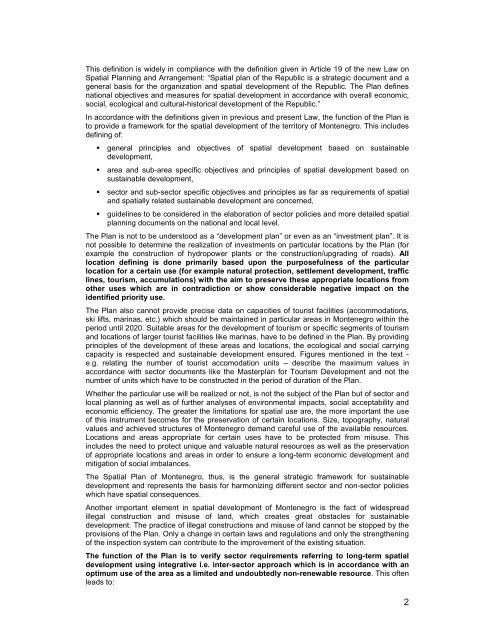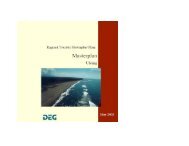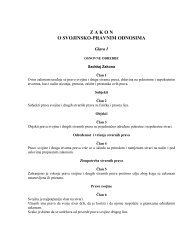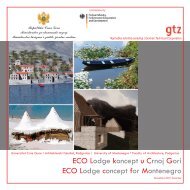Spatial plan of Montenegro until 2020 - Ada Bojana
Spatial plan of Montenegro until 2020 - Ada Bojana
Spatial plan of Montenegro until 2020 - Ada Bojana
You also want an ePaper? Increase the reach of your titles
YUMPU automatically turns print PDFs into web optimized ePapers that Google loves.
This definition is widely in compliance with the definition given in Article 19 <strong>of</strong> the new Law on<strong>Spatial</strong> Planning and Arrangement: “<strong>Spatial</strong> <strong>plan</strong> <strong>of</strong> the Republic is a strategic document and ageneral basis for the organization and spatial development <strong>of</strong> the Republic. The Plan definesnational objectives and measures for spatial development in accordance with overall economic,social, ecological and cultural-historical development <strong>of</strong> the Republic.”In accordance with the definitions given in previous and present Law, the function <strong>of</strong> the Plan isto provide a framework for the spatial development <strong>of</strong> the territory <strong>of</strong> <strong>Montenegro</strong>. This includesdefining <strong>of</strong>: general principles and objectives <strong>of</strong> spatial development based on sustainabledevelopment, area and sub-area specific objectives and principles <strong>of</strong> spatial development based onsustainable development, sector and sub-sector specific objectives and principles as far as requirements <strong>of</strong> spatialand spatially related sustainable development are concerned, guidelines to be considered in the elaboration <strong>of</strong> sector policies and more detailed spatial<strong>plan</strong>ning documents on the national and local level.The Plan is not to be understood as a “development <strong>plan</strong>” or even as an “investment <strong>plan</strong>”. It isnot possible to determine the realization <strong>of</strong> investments on particular locations by the Plan (forexample the construction <strong>of</strong> hydropower <strong>plan</strong>ts or the construction/upgrading <strong>of</strong> roads). Alllocation defining is done primarily based upon the purposefulness <strong>of</strong> the particularlocation for a certain use (for example natural protection, settlement development, trafficlines, tourism, accumulations) with the aim to preserve these appropriate locations fromother uses which are in contradiction or show considerable negative impact on theidentified priority use.The Plan also cannot provide precise data on capacities <strong>of</strong> tourist facilities (accommodations,ski lifts, marinas, etc.) which should be maintained in particular areas in <strong>Montenegro</strong> within theperiod <strong>until</strong> <strong>2020</strong>. Suitable areas for the development <strong>of</strong> tourism or specific segments <strong>of</strong> tourismand locations <strong>of</strong> larger tourist facilities like marinas, have to be defined in the Plan. By providingprinciples <strong>of</strong> the development <strong>of</strong> these areas and locations, the ecological and social carryingcapacity is respected and sustainable development ensured. Figures mentioned in the text -e.g. relating the number <strong>of</strong> tourist accomodation units – describe the maximum values inaccordance with sector documents like the Master<strong>plan</strong> for Tourism Development and not thenumber <strong>of</strong> units which have to be constructed in the period <strong>of</strong> duration <strong>of</strong> the Plan.Whether the particular use will be realized or not, is not the subject <strong>of</strong> the Plan but <strong>of</strong> sector andlocal <strong>plan</strong>ning as well as <strong>of</strong> further analyses <strong>of</strong> environmental impacts, social acceptability andeconomic efficiency. The greater the limitations for spatial use are, the more important the use<strong>of</strong> this instrument becomes for the preservation <strong>of</strong> certain locations. Size, topography, naturalvalues and achieved structures <strong>of</strong> <strong>Montenegro</strong> demand careful use <strong>of</strong> the available resources.Locations and areas appropriate for certain uses have to be protected from misuse. Thisincludes the need to protect unique and valuable natural resources as well as the preservation<strong>of</strong> appropriate locations and areas in order to ensure a long-term economic development andmitigation <strong>of</strong> social imbalances.The <strong>Spatial</strong> Plan <strong>of</strong> <strong>Montenegro</strong>, thus, is the general strategic framework for sustainabledevelopment and represents the basis for harmonizing different sector and non-sector policieswhich have spatial consequences.Another important element in spatial development <strong>of</strong> <strong>Montenegro</strong> is the fact <strong>of</strong> widespreadillegal construction and misuse <strong>of</strong> land, which creates great obstacles for sustainabledevelopment. The practice <strong>of</strong> illegal constructions and misuse <strong>of</strong> land cannot be stopped by theprovisions <strong>of</strong> the Plan. Only a change in certain laws and regulations and only the strengthening<strong>of</strong> the inspection system can contribute to the improvement <strong>of</strong> the existing situation.The function <strong>of</strong> the Plan is to verify sector requirements referring to long-term spatialdevelopment using integrative i.e. inter-sector approach which is in accordance with anoptimum use <strong>of</strong> the area as a limited and undoubtedly non-renewable resource. This <strong>of</strong>tenleads to:2







